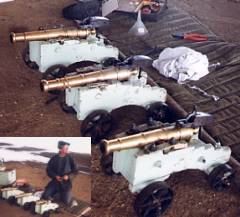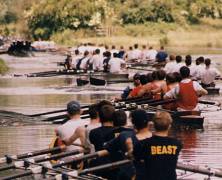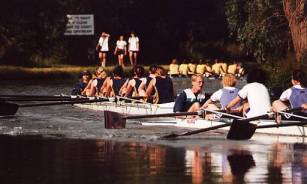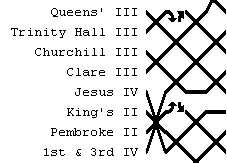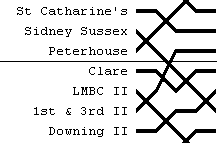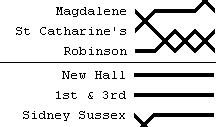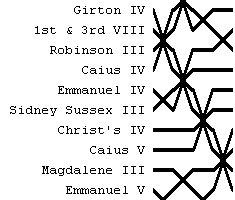Rowing at University in Cambridge
The Bumps
How They Work
- Divisions
- The start
- Bumps, overbumps and the new start order
- Moving between divisions - the sandwich boat
- Lent and May bumps - days and dates
- The Getting On Race
Divisions
As with most large rowing events, the bumps are run in divisions. Each division comprises 17 crews which line up one every 150 feet between Baits Bite lock and First Post Corner. In the Lent Bumps there are 4 men's divisions and 3 women's, and in the May Bumps, 6 men's divisions and 4 women's.
| |||||||||||||||
In addition, the top boat from each division (called the sandwich boat) races for a second time as the 18th crew at the foot of the division above . The bottom division comprises 18 boats rather than 17 - making a total of 103 men's crews and 69 women's in the Mays.
The Start
The start of each division is marked by the firing of a small cannon from just upstream of the motorway bridge. Warning shots are fired with 4 minutes to go and 1 minute to go, by which time if all is well the crews will be pulled in to the bank in position and ready to go.
| |||||||||||||||
The spacing of the crews (one every two and a half lengths) is marked out on the river bank, and there is a long length of chain, with a large cork or bung at the end, attached to the bank at each "station". Each cox holds this bung - clearly above his head or to the side - until the racing starts.
With about 20 seconds to go, each crew's coach or boatman uses a long pole to gently push the boat out away from the bank, and the crews 'come forwards' ready to race in anticipation of the final gun shot.The chain being held by the cox ensures that each boat is within a certain distance of its station. It is usual to attempt to position the boat ahead of it's station at the end of the chain, but this is at the risk of running out of chain and having the cox fighting to hold on to it whilst trying desparately to keep the boat straight!
| |||||||||||||||
Bumps, Overbumps, and the New Starting Order
To achieve a bump, any part of your boat, crew or blades must physically touch any part of the boat, oarsmen or blades of the crew ahead. Often the bumping crew's bows will make contact with stroke or 7's blade of the boat ahead - requiring a good deal of overlap between the crews before a bump is won.
When the crew being bumped believes it has been hit or wishes to concede, the cox acknowledges the bump by raising his arm clearly. If the cox of the loosing crew is slow to acknowledge the bump, then the situation can quickly become quite dangerous; if they refuse to acknowledge then they can sometimes find a blade, or more seriously the bows, striking them in the back - at which point there is generally very little further delay!
 |
||
| Steph Richards acknowledging a bump - 1st & 3rd III going down to Robinson II, Mays 2000 | ||
In high divisions, the racing is generally fairly close and often lasts for much of the course, but in lower divisions the difference in standard between crews increases, along with the general chaos - and bumps can happen very quickly. If the speed of two boats is dramatically different then blades and sometimes boats can be damaged - to the dispair of boatman but the delight of spectators!
| |||||||||||||||
After a bump, the two crews both stop racing and attempt to manouveur to the side of the river, to allow crews behind to continue. If you find that the two crews ahead have 'bumped out' in this way, then you clearly can no longer win a bump yourself. All is not necessarily lost, however, since you may have the chance to bump the crew who started three places ahead of you - called an over-bump. Double over-bumps (going up or down 5) are also seen from time to time (the bumps chart shows Pembroke II double over-bumping Trinity Hall III in the 1999 May Bumps), and whilst triple over-bumps are usually extremely rare, there were two in the May bumps 2001 - one of which saw our 3rd men's boat being hit by Homerton I, who started a whopping 7 places (that's 16 and a half boat lengths - or about 300m) behind us.
For the next day's racing, the two crews that hit each other simply swap places. If your boat bumps, you therefore go up one in the starting order. If you neither bump or get bumped, it is called 'rowing over' and you retain the same starting position.
Changing Divisions; the Sandwich Boat
| |||||||||||||||
The sandwich boat is the name given to the crew at the top of each division (apart from the crew at the Head of the River), which after it has raced its own division has the chance to bump up to the division above by racing again as that division's 18th crew. If a crew starts 2nd in a division, it is therefore possible for it to go up 2 on one day (and perhaps 5 places in total if it bumps every other day too) - as illustrated by 1st and 3rd II in the bumps chart on the right. This represent a bump on Clare at the top of the 2nd division and a bump on Sidney Sussex in a second row an hour and a half later as sandwich boat in the 1st division. The chart shows the boundary between the 1st and 2nd divisions of the May bumps in 1999.
| |||||||||||||||
If a sandwich boat finds itself unable to bump the 17th boat in its second race each day, it can become a very tiring week - with up to 8 races in 4 days! This ordeal was survived by New Hall I, for example, in the May Bumps in 1999 when they held the position shown in the chart (showing the boundary between the 1st and 2nd women's divisions of the Mays in 1999) on the left, whilst Magdalene and Robinson had something of a tussle ahead.
Lent and May races
The bumps basically take place on eight days of the year - for four days in week six of Lent term (early March) and four days after exams in May term (mid June). These two sets of bumps are called the Lent Bumps (or Lents) and the May Bumps (or Mays) respectively. The starting orders for the two sets of bumps are independent - that is that order for the Lents this year follows from the finishing order of the Lents last year, and the same for the Mays. This is to make the racing fairer if University level oarsmen are not spread evenly between clubs, and also to account for the much larger scale of the (warmer) Mays.
Although each crew still races on only four days (apart from some sandwich boats...), the Lent Bumps are actually spread over five and so run from Tuesday to Saturday, to reduce the number of people needing to miss morning lectures. They run in the 6th full week of lectures of Lent term.
The May bumps are run more simply over four days - from Wednesday to Saturday - and they happen when the stress of work and exams are over and before May week, in June (technically the 8th week of term).
The Getting On Race
| |||||||||||||||
The last piece of the jigsaw is the fate of those crews who don't already have a place on the river from the previous year's races. If there are more crews entered than places on the river, up to ten crews are taken from the bottom of the starting order and entered along with new entrants in the 'Getting On Race'. This takes the form of a time trial over the 2000 m University IVs course (little bridge post to post before the railway bridge). Unless there are a very large number of entries, one in three crews are successful and win places in the bumps - which is called 'rowing on'.
Those crews who had places in the bottom division the previous year are placed in the order in which they then finished, ahead of new entrants which are put on in a random order. By bumping up out of the bottom ten crews, a crew can win its club another 'permanent' place on the river for the following year.
It is often the case that the crews which are successful in the getting on race are generally much quicker than the crews in the upper half of the bottom division (which do not have to Row On) - and this often results in particularly dramatic bumps and over bumps in the sixth division. The chart shows Girton IV and 1st & 3rd VIII being overbumped numerous times by crews which rowed on - finishing in the same order but down a depressing, albeit entertaining, 8 places!
Next: The Hooter system and Bumping, celebrating, winning Blades, and going Head.


